Radar Transceivers: Key Components for ADAS & Autonomous Driving
- Blog 1: Why Do We Need Radar?
- Blog 2: Basics of FMCW Radar
- Blog 3: Radar Range: How Far Can a Radar "See"?
- Blog 4: Radar Resolution: How Accurate Can a Radar Be?
- Blog 5: Radar Architecture: How to Connect Different Radar Sensors
- Blog 6: How to connect the antennas?
- Blog 7: Antennas for Automotive Radar
In the previous entries of this blog dedicated to automotive radar, the reason for using radar and the principle of operation of the frequency modulated continuous wave radar were presented. Now, we will focus on the performance of the system, starting with its maximum detection range: how far can we detect an obstacle ahead? We need to have as much foresight as possible, to be able to detect an obstacle and take the required action (Figure 1). And, what are the parameters of the radar MMIC transceiver, which can be optimized, to extend this range?
Of course, depending on the application, the expectations on the range will vary. For example, Long Range Radar (LRR) will not require high resolution or a wide field of view but will aim to achieve the highest possible range, to increase the reaction time and avoid accidents while driving at high speed. On the other hand, Short Range Radar (SRR) does not need to look very far ahead, preferring to have a higher resolution and field of view. Yet, even in this configuration, any additional centimeter which can be added to the range may help prevent accidents in complex driving environments, such as cities or crowded parking lots.

Radar Detection Range and Radar Range Equation
Many factors will influence the radar detection range, which cannot be controlled by the designers. Therefore, in the first step, we need to work with the basic information available, related to the propagation of the electromagnetic waves and the analog front-end.
The radar range R is directly linked to the RF performance of the radar MMIC transceiver through its link budget, which in this case is called the radar range equation, which provides the power delivered to the RF receiver frontend Pr as a function of the output power of the transmitter frontend (Pt), the gain of the transmit and receive antennas (Gtx and Grx), the frequency of operation (through the wavelength λ) and the radar cross-section of the target (σ):

The term λ4/(4π∙R)4 represents the two-way free-space loss, while (4π∙σ)/λ2 accounts for the reflection on the target. The link budget and the different contributions to the radar equation are illustrated in Figure 2.
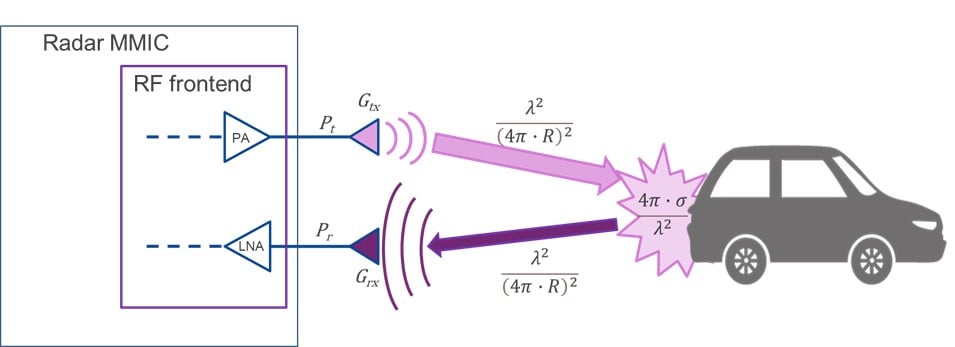
In its system reference document ETSI TR 103 593 V1.1.1 (2020-05) “Transmission characteristics; Technical characteristics for radiodetermination equipment for ground-based vehicular applications within the frequency range 77GHz to 81GHz”, the European Telecommunications Standards Institute (ETSI) provides a set of assumed values for the gain of the antennas in different radar operation modes (see Table 1) and the minimum detection power for the receiving chain (-110dBm). Reference radar cross-section values for typical targets are also listed (Table 2).
Table 1. Assumptions for radar sensor antenna gain according to ETSI TR 103 593 V1.1.1 (2020-05) (Gtx=Grx assumed)

Table 2. Radar cross-section values for typical targets according to ETSI TR 103 593 V1.1.1 (2020-05)

These values can be used as a baseline for assessing and comparing the theoretical performance of different radar systems.
Radar MMIC
Nowadays, these transceivers are silicon RFICs (Radio Frequency Integrated Circuits), which allow not only for the integrating of multiple functions on a single chip but also for having multiple transmit and receive channels, as required for automotive radar. Transitioning to CMOS (Complementary Metal Oxide Semiconductor) will lower the cost and power consumption of radar MMICs. CMOS is also quite impervious to variations in temperature, which is a desired feature in harsh automotive environments. An example of the block diagram of a transceiver MMIC is presented in Figure 3.
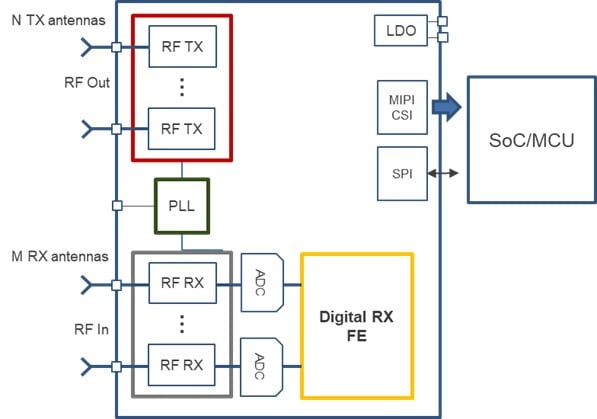
The overall performance of a radar system will be strongly affected by the performance of the analog RF transmit and receive in the radar MMIC transceiver. In the case of the range limitations, two main parameters need to be considered: the output power of the transmitter and the noise figure of the receiver.
Transmitted Power
The power delivered by each transit chain of the MMIC will be key for the radar performance. For that, we must consider the output power of the RF power amplifier. Based on this parameter, and considering the radar equation presented above, the maximum achievable range in an ideal situation for given receiver sensitivity (Prmin) can be calculated as:

This equation shows that increasing the transmitted power P_t will automatically extend the range of the radar. For example, 1dB more of output power in a Long Range Radar (LRR) will give us 2.8m to detect a bike, 6m for a motorbike and 11m for a typical car, as shown in Figure 4. When driving at high speed in a motorway, this can mean the difference between braking on time or crashing into an unexpected traffic obstacle.
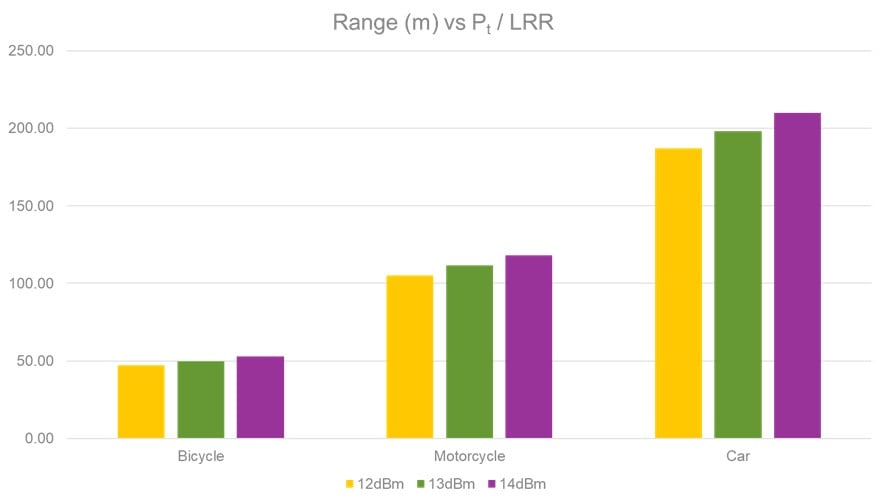
But the benefits of increasing the output power can also be seen in short-range applications. For a USRR (Ultra-Short Range Radar), a 1dB increase in the transmitted power will mean gaining 35cm to 50cm or detecting a small child, a pedestrian or a bike, as shown in Figure 5. This is especially important for driving in crowded urban environments to avoid accidents with highly vulnerable victims.
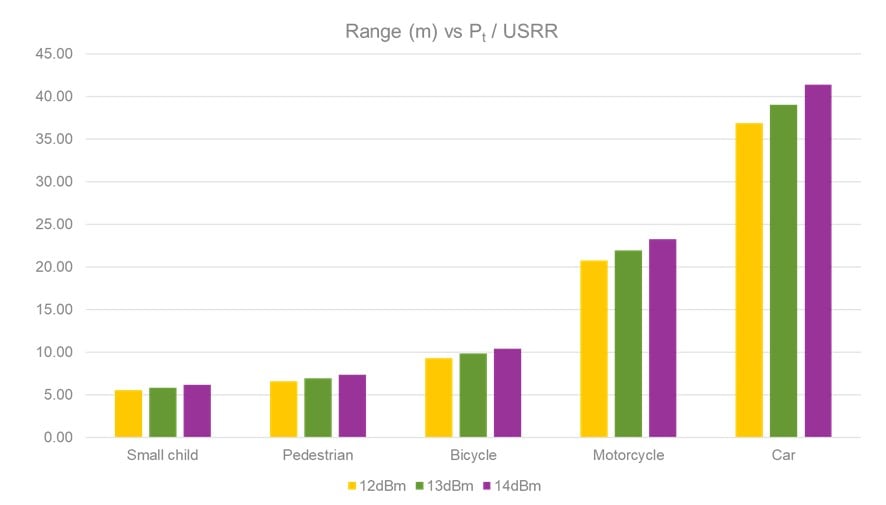
Of course, these calculations do not consider additional losses in real scenarios (e.g., rain, multipath propagation…) All these factors will reduce the radar detection range with respect to the ideal situation. For example, radar modules are usually placed behind the car’s emblem or the bumpers. The bumper fascia will introduce 2dB to 8dB losses, depending on their composition and paint. This translates into an 11% to 37% loss in the detection range. Providing as much output as possible helps offset this problem. Optimizing the performance of the RF transmit chains, especially the last stage of the power amplifiers, is therefore of capital importance.
Noise Figure
In addition to the detection threshold, a minimum signal-to-noise ratio (SNR) will be required by the system, to perform the radar processing. The SNR of the radar receiver is the ration between the received power Pr and the noise power N. It can be derived from the radar equation considering the ambient temperature T and the signal duration Tmeas:

Where k the Bolzmann constant and F the noise factor (in dB, noise figure NF), which accounts for the noise contribution from the receiver.
Given a certain detection threshold SNRmin, the maximum theoretically achievable range can be determined as:

This equation shows that by reducing the noise factor F (and, conversely, the noise figure NF), the radar detection range will be increased. Let us assume the system requires an SNR threshold of 20dB and let us consider the same examples as above.
In the case of an LRR, as shown in Figure 6, reducing the noise figure by 1dB will increase the range by 4m (bike), 10m (motorbike) and 13m (car).
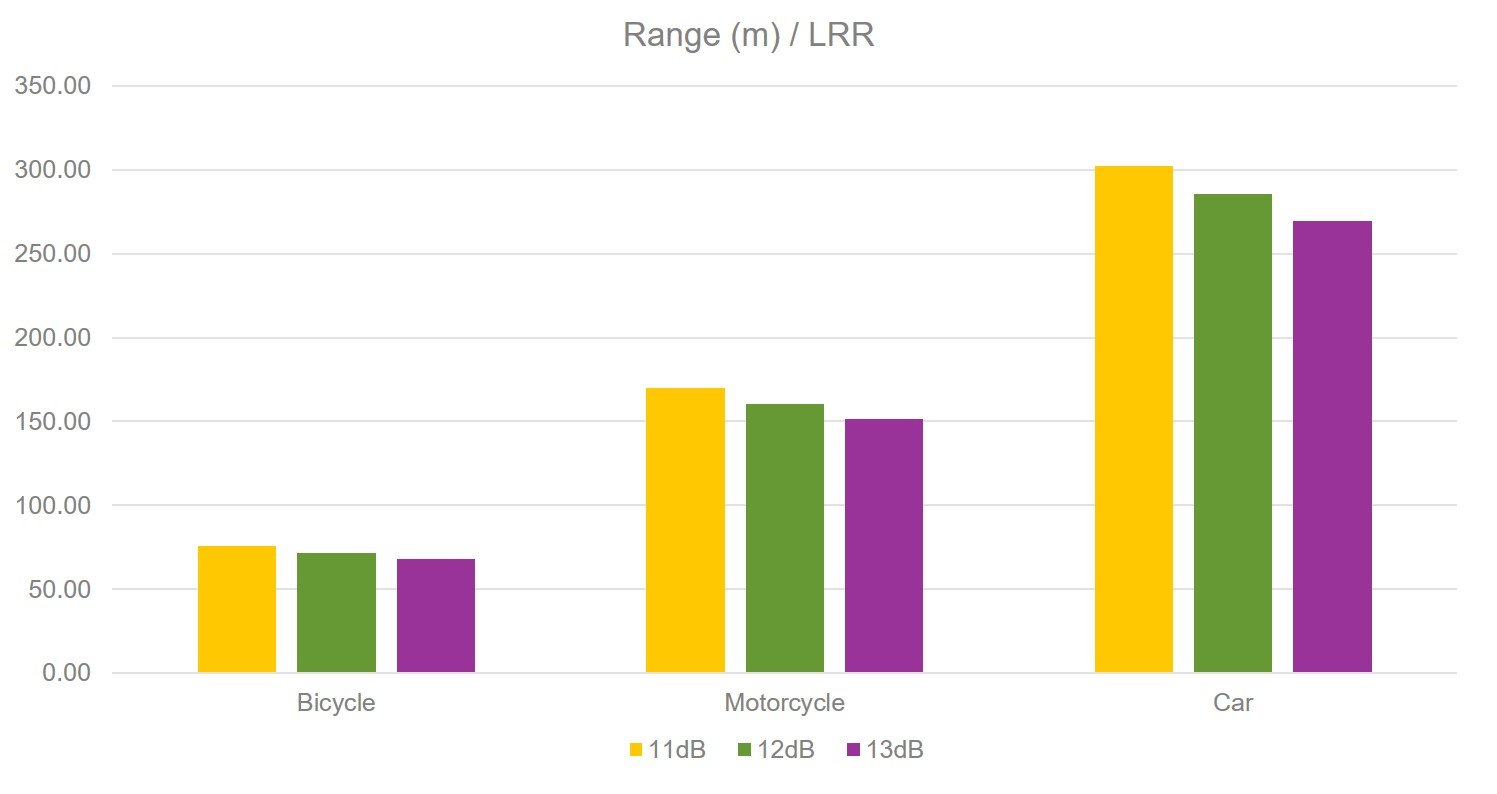
This range increase is also significant in the short range, where 50cm to 1m can be won for the detection of the most vulnerable traffic participants (children and adult pedestrians and bicycles) by lowering 1dB of the noise figure, as shown in Figure 7.
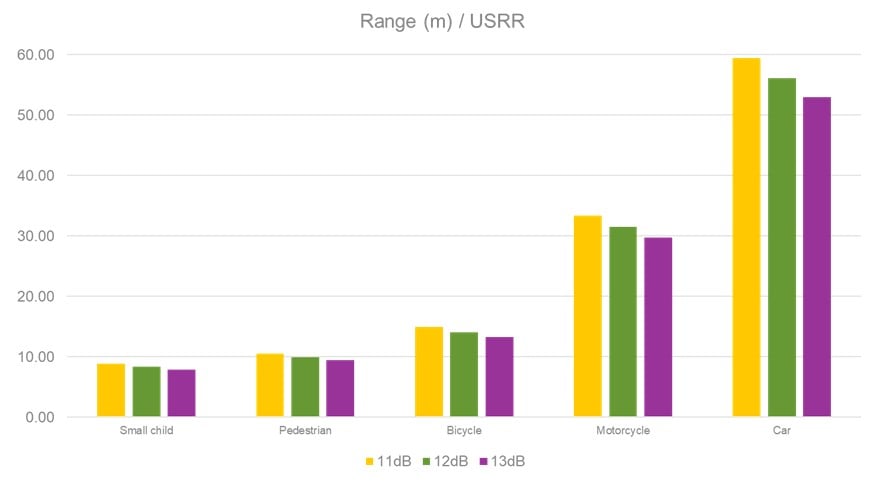
The noise figure of the receiver chain will thus also be a critical parameter for the design of a radar MMIC transceiver. As the main contributor to the noise is the first amplifier in the analog receiving chain (Figure 8), the LNAs in the radar MMIC transceiver should be carefully designed and optimized for low noise figures.
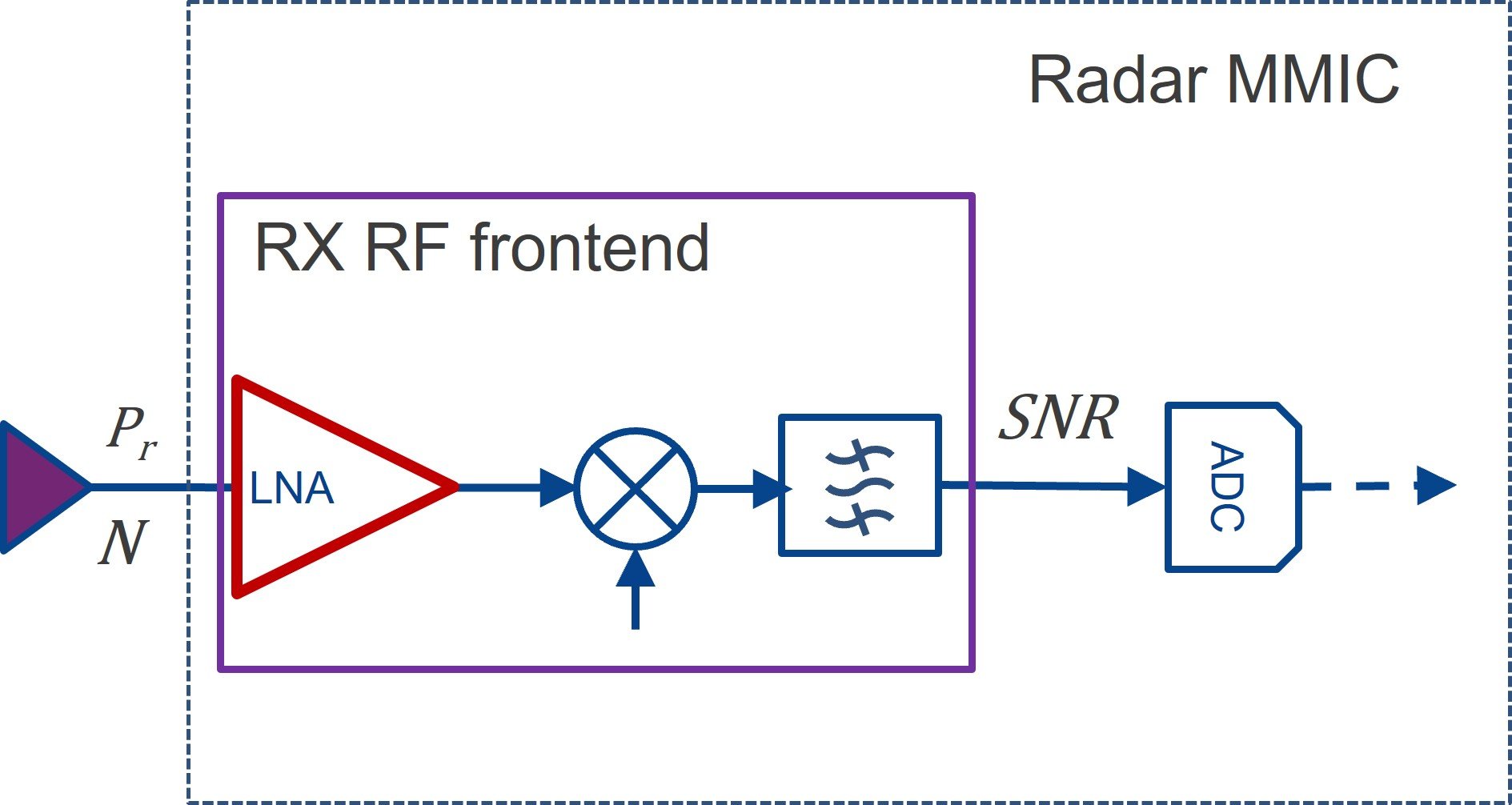
Design Trade-offs
In view of these results, there are therefore two critical design parameters if we want to extend the range of a radar system by optimizing its RF performance of the radar MMIC transceiver, namely, the output power and the noise figure. Better performance in any of them will increase the detection range. But which one should be chosen for optimization?
Having a higher output power will help compensate for additional losses caused by the real-life environment. Additionally, it will provide better protection against interference. On the other hand, the MMIC will have a higher consumption and power dissipation. This problem will be increased with the integration of a higher number of transmit channels.
If power consumption is critical, adjusting the noise figure could be the better option. This is an elegant solution for energy-efficient MMICs. Yet, a low noise figure will require higher RX gain, which in turn can affect the linearity of the receiver. Moreover, there may be less protection against interference, as unwanted signals will be amplified along the desired signals.
Ideally, both should be tuned as much as possible, considering the limitations of the chosen semiconductor technology and the overall system design.
Conclusion
In this entry, the limitations and design parameters for radar range detection have been presented. Of course, we have focused exclusively on the RF performance of the MMIC. There are also additional parameters of the radar MMIC which can limit the range, such as the analog-to-digital converter (ADC). The range can also be increased by optimizing the digital receive and processing chain so that useful signals can be obtained for lower received power and SNRs.
In the next entry of the blog, we will dig into the accuracy and resolution of a radar system.
